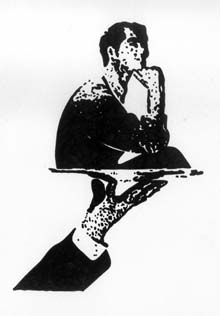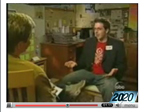
 The origin of the term “thought leader” goes back a few years.
The origin of the term “thought leader” goes back a few years.
Joel Kurtzman, editor-in-chief of Strategy & Business magazine, first coined the expression in 1994.
According to Wikipedia, the term was used to designate interview subjects for that magazine who had contributed new thoughts to business.
Since that time, the term has spread from business to other disciplines and has come to mean “someone who enlivens old processes with new ideas.”
AND, HERE’S THE GOOD NEWS: you CAN become one too!
But.
HERE’S THE BAD NEWS: the media, the blogosphere and the business world seem to be debating the validity of this term.
That it’s overused.
That it’s contrived.
That it’s meaningless.
Probably because people just LOVE to throw around expressions like this.
For example, author/blogger Brian Carroll from Lead Generation Blog says, “First of all, thought leaders don’t refer to themselves as thought leaders. Thought leadership is an outside assessment based on what others say about you, not what YOU say about you.”
However, Carroll still defends the expression. “I rather like it,” he says, “even thought some people abuse it as a hollow form of self-promotion.”
Personally, I think the idea of being a thought leader is cool.
Not that you should go around telling people, “Hey, look at me! I’m a thought leader!”
That might sound kind of pretentious.
So, maybe it’s better as a frame of mind.
An attitude.
A way of doing business.
A way of treating people.
Controversies aside, here’s the bottom line about thought leadership:
If you do it respectfully, authentically, intelligently and uniquely, you will get people to come to you.
Actually, wait a sec. I’m wrong.
I shouldn’t have said, “DO it.”
I should have said, “LIVE it.”
Because being a thought leader isn’t something you DO.
Being a thought leader is something you ARE.
Approachability?
Being That Guy?
Making a name for yourself?
Being a thought leader is a HUGE part of that.
Because it’s another way of sticking yourself out there.
So, if you think you’re up to the challenge (and yes, it IS challenging) consider these 17 strategies for becoming a thought leader:
1. Pay the price. You won’t become a thought leader overnight. Which doesn’t mean that it takes lots of physical time; but it DOES take experience. Get it any way you can. For example, check out this list called 38 Ways to Speed Up Your Learning Curve.
2. Learn well. Become an expert at learning from your experiences. After all, people don’t care what you know. They don’t care what you did. They only care what you LEARNED. And, how those lessons can help them become better.
3. Write, write and write. Did I say write? Writing is the basis of all wealth. If you’re not capturing your thoughts, ideas, experiences, stories, advice and insights, forget all about this whole thought leader thing. Get a blog and get on www.ezinearticles.com. Today.
4. Read everything. When I first starting giving speeches and writing books, my mentor told me, “You have no right to write or speak about any topic unless you’ve read every book ever written on that topic.” Also, DeBono said, “The thinker should be able to look at the thinking used by other people or used in general about a particular subject. Looking at the thinking of others does not mean doing so with the aim of criticizing or attacking it. The intention is to watch what thinking is being applied.” What about you? Have you read everything else?
5. Read more. Also seek out books such as The Obvious Expert, Thinking for a Change and How to be a Thought Leader. Great advice and easy to read.
6. Read even more. Lastly, read books about lateral thinking and creativity (ahem, DeBono). Explore biographies about the world’s greatest thinkers, i.e., Einstein and da Vinci.
7. Hang with other thought leaders. Start a mastermind group, thinking club or online discussion with other thought leaders. Pick brains often. Stop hanging around people who don’t think thinking is cool.
8. Speak. At every club, meeting, tradeshow, conference, chamber, rotary and street corner you can find. If they pay, great. If not, no biggie. Either way, you need to be fun, fun-ny, informative and entertaining. Talk about ONE THING, and have a little laminated double-sided philosophy card as your handout.
9. Philosophy. Ask yourself this question: “If everybody did EXACTLY what I said, what would the world look like?” You answer(s) = your philosophy. Shout it from the rooftops. Be known for it.
10. Reinvent the wheel. Figure out what everybody else is saying about your area of expertise. Then figure out YOUR unique perspective, spin, paradigm, etc. Find the hole that nobody sees and fill it with your unique expertise. (Hey, wait! That last sentence TOTALLY rhymed. Sweet. I’m writing that one down.)
11. Become a CONFIDENT thinker. In the book A Thinking Course, Edward DeBono said, “A thinker should be able to turn on his thinking at will. A thinker should be able to direct his thinking to any subject or any aspect of a subject. A confident thinker does not have to prove himself right and the other person wrong. Thinking is an operating skill, not an ego-achievement. A confident thinker is willing to set out to think about something.” Wow. Talk about a thought leader! WHAT ABOUT YOU: can you speak on your expertise … forever?
12. Content is king. Content drives action. Content replaces selling. Content replaces agents. Content replaces pitching. Content drives transactions. Content replaces advertising. Content replaces cold calling. Content pulls instead of pushes. (Read 16 more reasons why content is king!)
13. Become a media darling. Build relationships with local (and hopefully, national!) press. Offer yourself as a resource and expert. Send them business cards ALREADY stapled to a Rolodex card. Make yourself easily available. REMEMBER: the media is your customer. (Speaking of media darlings, I just did an this article with The Daily Record.)
14. Stay in front of your fans. Blog or no blog, you still need to be writing and publishing SOME form of newsletter. At least once a month. Make it quick, easy to read and packed with practical content. (See #12) Oh, and don’t sell too much. Selling annoys readers.
15. Be open mentally. DeBono also says, “A confident thinker is willing to listen to others. He is willing to improve his thinking by acquiring a new idea or a new way of looking at things. He is also able to acknowledge that an answer has not been found. Besides, being right is really boring.” LESSON LEARNED: be open to other thought leaders’ ideas.
16. Be open physically. On your blog, be sure to leave the “comments” button on. And make them available to anybody, even anonymous readers. Transparency and openness apply online too.
17. Close with value. At the end of every article, blog post, video or piece of content you publish, be sure your sign-off accomplishes a few things. FIRST, tell people what you do, how you do it and who you do it for. SECOND, offer an easy way to get in touch with you. THIRD, have a call to action, i.e., a free report, a video to watch, a link to click, an exercise, a thought-provoking question, an email assignment, free access to your online library or a 15-minute consultation.
LET ME ASK YA THIS…
Are you a thought leader?
LET ME SUGGEST THIS…
Tell us how you became one!
* * * *
Scott Ginsberg
That Guy with the Nametag
www.hellomynameisscott.com
 Are you the luckiest person you know?
Are you the luckiest person you know?
Watch Scott’s interview on 20/20!
